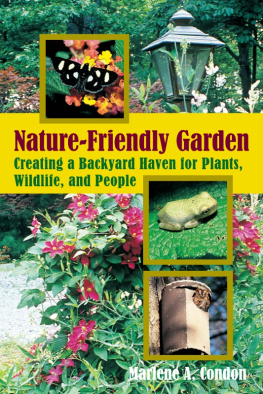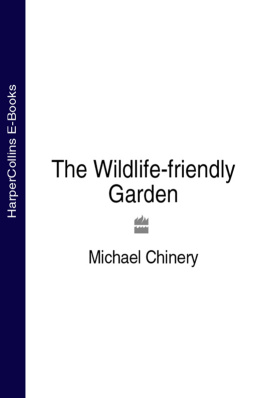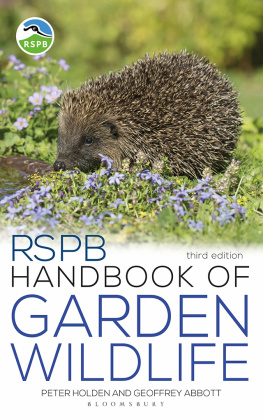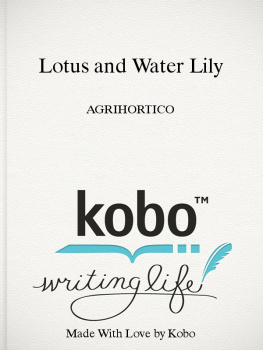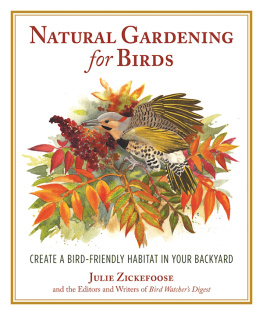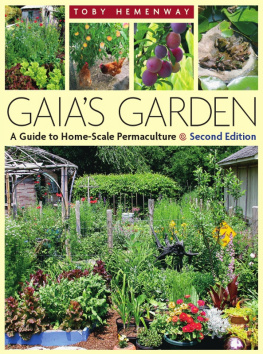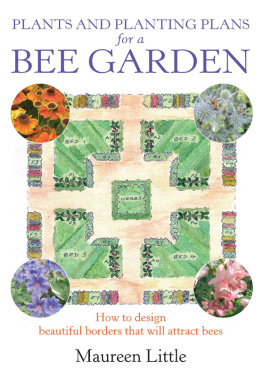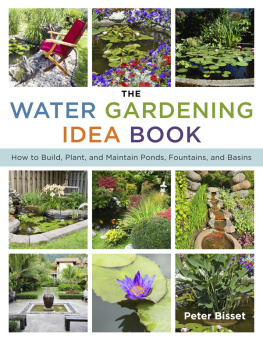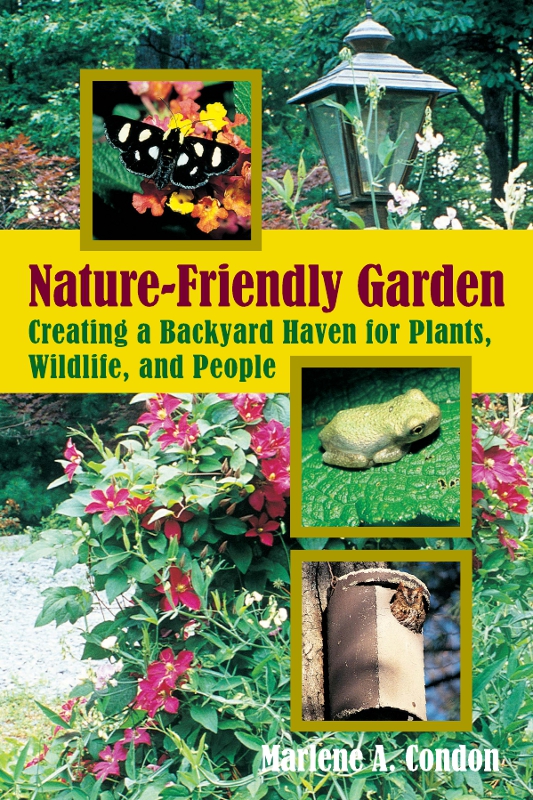
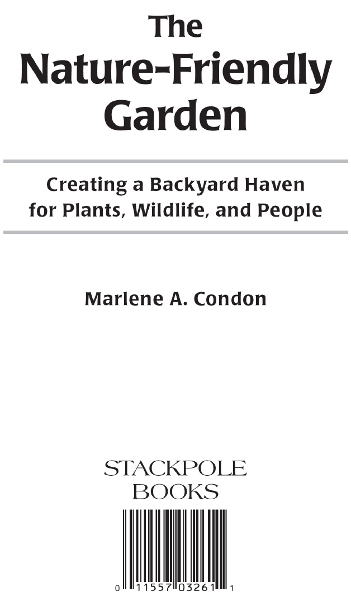
Copyright 2006 by Stackpole Books
Published by
STACKPOLE BOOKS
5067 Ritter Rd.
Mechanicsburg, PA 17055
www.stackpolebooks.com
All rights reserved, including the right to reproduce this book or portions thereof in any form or by any means, electronic or mechanical, including photocopying, recording, or by any information storage and retrieval system, without permission in writing from the publisher. All inquiries should be addressed to Stackpole Books, 5067 Ritter Road, Mechanicsburg, Pennsylvania 17055.
Printed in China
First edition
10 9 8 7 6 5 4 3 2 1
Cover design by Caroline Stover
All photographs by the author
Cover photographs: Top: Eight-spotted Forester moth (Alypia octomaculata) on Lantana camara; Middle: Gray Treefrog (Hyla versicolor); Bottom: Red-phase Eastern Screech-Owl (Megascops asio); Background: Lamppost with Clematis
Library of Congress Cataloging-in-Publication Data
Condon, Marlene A.
The nature-friendly garden : creating a backyard haven for plants, wildlife, and people / Marlene A. Condon.
p. cm.
Includes bibliographical references and index.
ISBN-13: 978-0-8117-3261-1 (alk. paper)
ISBN-10: 0-8117-3261-4 (alk. paper)
1. Landscape gardening. 2. Natural landscaping. 3. Gardening to attract wildlife. I. Title.
SB473.C652 2006
639.9'2dc22
2005030354
eBook ISBN: 9780811749107
This book is dedicated to:
Donna Bennett, who first encouraged me to share my nature observations with the public;
Dave and Judy Bonnett, who really pushed me to write at a professional level about the natural world;
and Richard Dick Morton, who always inspired me by bestowing such high praise upon my work.
Contents
Acknowledgments
I want to express my deepest appreciation to my husband, Robert, without whose support I could never have come this far, and to my Mom-in-law, Barbara Butler, who patiently waited for the day my book would be finished so she could see me again! I am extremely grateful to Dr. Gregory Degnan of the University of Virginia Health System Department of Orthopaedic Surgery, under whose care I have been able to continue to take photographs and to make notes about my wildlife observations. I am also deeply indebted to Dr. William Dandridge, Jr., Dr. Robert L. Stokes, Jr., and their entire staff for managing my overall health care with a superabundance of compassion and kindness. My thanks to The Camera Center, Carys Camera Center, and Stubblefields (especially to Coe Sweet) of Charlottesville, Virginia, for the care they have shown my film and the helpful advice they have given me regarding photography. I am indebted to Pro Camera for help in procuring camera accessories and for photographic equipment repairs. I would like to thank Virginia Glass of Charlottesville for providing me with quality windows through which to watch and photograph wildlife. I am grateful to the staff of the The Daily Progress (especially Anita Shelburne and Pat Alther) for giving me the opportunity to write my first newspaper column and to Spike Knuth and Lee Walker of the Virginia Department of Game and Inland Fisheries for giving me the chance to write my first monthly magazine column, in Virginia Wildlife. And my sincere gratitude to Jim Condon, who bought me my first computer (along with a program to teach me how to type!) and my first real camera with an excellent lens to capture the wildlife that I love so very much.
Introduction
D o you believe that wildlife and gardens are compatible? Unfortunately, the majority of people who garden have been led to believe that growing plants successfully can only be done at the expense of the natural world. They presume that wildlife is neither wanted nor needed, and they declare warquite often of the chemical kindon invading plants and pests. But war is always stressful, not to mention dangerous. It is not pleasant to be constantly worrying about your cultivated plants, and most pesticides can be as troublesome to people as they are to other organisms.
My yard (which is probably less than half an acre in size) is different from the typical lawn that has just a few shrubs, trees, and flowers. The average grass-filled yard supports very little wildlife, which makes it prone to a host of problems. (It is also quite boring, in my opinion. A yard without much wildlife is a yard without much action!) I have always encouraged wildlife to coexist with me wherever I have lived, andcontrary to what you might expectI have been able to grow more than enough fruits and vegetables for eating and preserving.
The mostly unrecognized truth is that our yards and gardens need to function in much the same way as a wilderness area does. A gardener who obeys the laws of the natural world owns a garden that is home to numerous organisms (predators and prey) that keep it functioning properly and trouble-free. I call this living in agreement with nature.
There are numerous benefits to living in agreement with nature. First and foremost, you can enjoy your garden instead of constantly fretting over it. Imagine walking out your door hoping to find a new plant or animal instead of worrying that you will encounter some new problem. The stress of gardening is replaced by the thrill of discoveryand with discovery comes free entertainment.
Many people spend time and money traveling to national parks and federal or state management areas in order to observe wildlife. But by gardening in a more natural manner, you may actually see more wildlife from the comfort of your own home than you ever will in an area where the animals are trying to hide from the crowds.
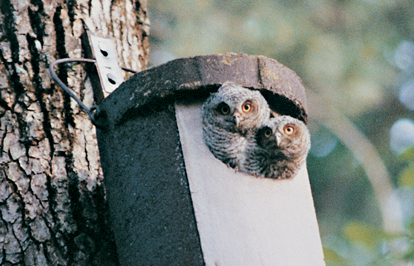
Two young Eastern Screech-Owls look out of their nesting box in the authors yard a few days before venturing out into the world.
When I tell people that I get to see an owl almost every day, during daylight hours, from fall through spring, they tend to be incredulous. After all, most people have never seen an owl in their lives. You can imagine how folks feel when I add that nearly every spring my yard serves as home to an entire family of owls, affording me the grand opportunity to watch owlets.
But it is not by chance that I am given the opportunity to observe owls; they roost and nest close to my house because of how I manage my yard. When you garden naturally, you create a pesticide-free environment that is safe for wildlife as well as people and pets.
In addition to safety, there are other advantages. When you do not use pesticides, you can eat the fruits (and vegetables) of your labors right off the plants if you so desireno washing necessary! And, of course, a pesticide-free yard does not contribute toxic substances to the soil and water of your home and to properties nearby and downstream.
Furthermore, living in agreement with nature saves you money by replacing chemical fertilizers with natural ones such as dried stalks and leaves. The natural gardener can also save money by taking advantage of volunteer plantsthose that start growing in the yard without having been planted. Naturalized plants often offer just as much beauty for the homeowner (and value for wildlife) as cultivated plants bought from nurseries.
Next page
